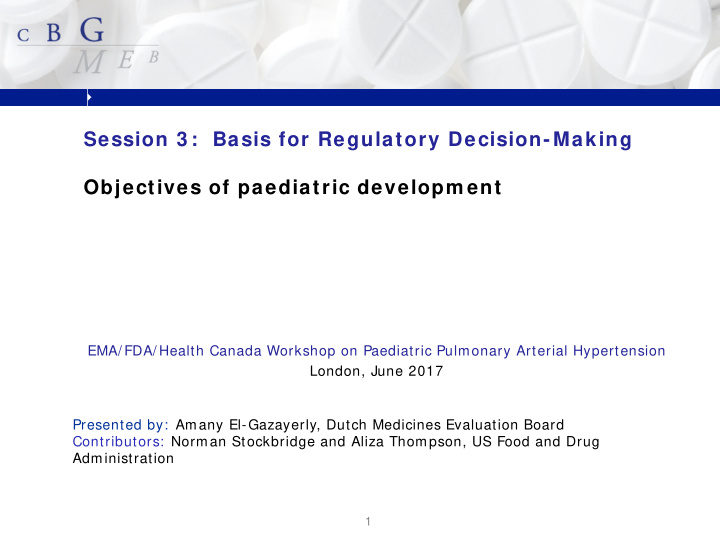



Session 3 : Basis for Regulatory Decision-Making Objectives of paediatric developm ent EMA/ FDA/ Health Canada Workshop on Paediatric Pulmonary Arterial Hypertension London, June 2017 Presented by: Amany El-Gazayerly, Dutch Medicines Evaluation Board Contributors: Norman Stockbridge and Aliza Thompson, US Food and Drug Administration 1
Disclaim er The viewpoints represented in this talk do not necessarily reflect those of the EMA/ FDA/ MEB. All presented data are obtained from public websites. 2
I ntroduction • No one wants to make the process of approving drugs for paediatric PAH patients more difficult than is necessary to provide adequate information to patients, parents, and caregivers on the drug’s safety and efficacy. • We, as regulatory agencies, have concluded that PK data alone (i.e., matching blood concentrations in pediatric patients with PAH to those achieved in adult patients with PAH) are not sufficient for this purpose. • Talk will explore considerations related to obtaining adequate information in pediatric patients with PAH and how different regulatory agencies have approached the issue. 3
Efficacy Considerations For drugs approved for use in adults with PAH, what is the minimum information needed to demonstrate the efficacy of the drug in paediatric PAH? Answer depends on: • whether the pediatric forms of PAH being studied are sufficiently similar to the forms in adults in which efficacy is established • whether biological systems targeted by particular agent are thought to be sufficiently similar in adults and children • other factors? The answer should not depend on which regulatory agency you ask 4
Survey Results Are there children with PAH who How established is that the biological have the same or a very similar systems operate similarly in adults disease to the disease in adults? and children W ell Not established established No Partially established Yes Regulatory Perspective? 5
EMA Pathophysiology of iPAH and aPAH in adults and paediatrics • Sufficient comparabilty allowing inference/ extension of efficacy for vasodilator products approved for adults. • Main remaining issues: Dose and long term Safety Dose • Comparable Exposure • Confirm with a PD endpoint • Haem odynam ic parameters 6
FDA Pathophysiology of iPAH and some forms of aPAH in adults and paediatrics • Sufficient comparabilty to allow borrowing some information from adults. • For vasodilators, the universal relationship between haemodynamics and exercise ability in adults allows one to infer effectiveness in paediatrics from the haemodynamic effects of the vasodilator in the pediatric population Dose • PK data alone only tell you how to match exposure in paediatric patients • PK data + the right PD metric can tell you what dose in paediatric patients will achieve a PD response that was associated with efficacy in adults 7
1 . Pharm acodynam ic Endpoints 1 . Right heart catheterisation • Ethical issues: Can you perform an invasive/ risky procedure as part of a study if it is not also part of standard care? • Recruitment problems • If implemented, are data representative? • Which measurement? PRVI, PAP, CO 2. Alternative, less invasive m ethods ? e.g., echocardiography • What further data are needed to provide confidence that treatment effects on specific ECHO parameters in pediatric patients will predict the treatment effects of vasodilator products approved for adults? 8
2 . Efficacy Endpoints I n a setting in w hich you cannot rely on a PD endpoint? Exercise Capacity • Developmentally able 6MWT CPET New: actigraphy? Clinical Events • Death • Hospitalisations for PAH • Signs and symptoms of right heart failure • Deterioration of disease (decrease in excercise capacity and WHO functional class, etc.) 9
Study Design 1 . Control Studies using a PD endpoint/ haemodynamic studies • A control arm may not be needed. • Comparisons between 2 doses. Efficacy studies • Challenging to conduct placebo-controlled trials Short term placebo withdrawal? 2 . Standard of care 10
3 . Age groups • Older age groups, can be included in adults studies • Developmentally able, can exercise • Limited data in non-developmentally able (clinical events? actigraphy? Or only haemodynamic data) 11
Safety • Alignment among regulatory agencies that development programs need to characterize safety in pediatric patients. • Safety database typically allows us to assess: – whether safety profile of drug is grossly similar to that seen adults – whether toxicities identified in adults occur in more severe form in pediatric patients or at a marked increase in rate – Developmental safety • Sometimes a signal/ toxicity not seen in adults is observed in pediatric patients–- can lead to further analyses/ investigations to try to determine whether the findings might be real/ reliable • Experience with “off-label” use of drug in pediatric patients (published reports/ safety reports submitted to regulatory authorities) also examined 12
Registries Registries can provide important information on: • the natural history of a disease that can be used to facilitate the conduct of pediatric trials • identify potential safety signals once drug is marketed Efficacy? Challenges: • If follow-up data not systematicallly collected in all patients, data from registry may not give an accurate understanding of the natural history of the disease • Bigger issue: Patients are not randomized to treatments so hard to draw conclusions about causal relationships Significant interest in randomized registry trials 13
Regulatory Perspectives What should labeling say if some data are available but effectiveness is not established? EMA FDA Safety and efficacy in children aged or Label would likely say that safety and any other effectiveness have not been relevant subsets have not yet been established; would not provide dosing established. recommendations – No data are available. or – Currently available data are described in section < 4.8> < 5.1> < 5.2> but no recommendation on a posology can be made Not always consistent Rationale : Use occurs; let prescriber Rationale : Labeling should not make the best decision one can. appear to support a use that you are not recommending 14
15
Recommend
More recommend